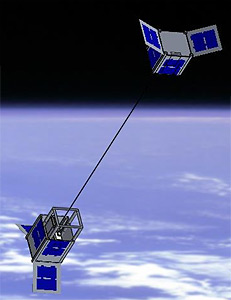
Once upon a time, entrepreneurs were counting down to a date in 2018 when the first space elevator would open for business. NASA was setting aside millions of dollars to promote the technologies required for building that elevator. And space elevator fans were looking forward to a breakthrough that would drive the cost of space travel down to mere hundreds of dollars.
Today, the countdown is on indefinite hold. The NASA money is gone. And the dream of building the space elevator has been eclipsed by billionaire Elon Musk’s dream of putting colonists on Mars by the mid-2020s.
Nevertheless, the fans are still keeping the faith, and they’re backing up that faith with research studies. About 35 of them gathered today at Seattle’s Museum of Flight to kick off the 2016 Space Elevator Conference, presented by the International Space Elevator Consortium.
Some attendees came from as far away as Norway and Japan.
“The goal is not an unreal goal,” Hugh Cook, a space systems engineer from the Los Angeles area, told GeekWire during one of the breaks. “I think about the audacity of the transcontinental railroad. It was a crazy idea, but eventually the fire was lit, and it happened.”
The analogy is apt: Like the transcontinental railroad, the concept behind the space elevator goes back to the 19th century, to Russian scientist Konstantin Tsiolkovsky’s musings in 1895.

The basic idea is that if you put a counterweight far enough from Earth, you could theoretically attach one end of a super-strong tether to the weight, and the other end to an anchor point on the planet. Then you could send people or payloads up and down that tether, as if they were riding a vertical railway to the sky.
Over the course of a century, engineers refined the concept and figured out that Earth’s counterweight would have to be placed about 62,000 miles (100,000 kilometers) above the planet’s surface. To handle the tension, the tether would have to be many times stronger than the strongest material available today.
Lots of details remain to be filled in, including exactly how the system would be built. But if it could be built, and if there were beam-powered rail cars capable of trundling up and down the tether, the cost of access to orbit would plummet. It would mark the beginning of a new space age.
To support technological development, NASA allocated prize money for a couple of challenges more than a decade ago. In 2009, Seattle-based LaserMotive won $900,000 of NASA’s money in a Power Beaming Challenge. As much as $2 million was set aside for a Strong Tether Challenge, but no one won a prize.
More recently, researchers have come up with reasons not to try building a space elevator. In June, Chinese researchers reported that a single defect in a tether made of super-strong carbon nanotubes could cause the tether to fail. Other studies have questioned how a space elevator would cope with bad weather, or space debris, or terrorists.
“A lot of people you know will tell you, forget about it,” said Bryan Laubscher, the founder of a carbon nanotube startup called Odysseus Technologies and director of the International Space Elevator Consortium.
But here’s what Pete Swan, the consortium’s president, will tell you: “Let’s gain some funding to do some really hard engineering work.”
https://www.youtube.com/watch?v=Xskh7gn925A
If Swan came across a billionaire who wanted to provide the funding, he would recommend spending $1 million to $5 million per year over the course of three to five years. “That would pay dividends for the whole project,” Swan said.
Swan acknowledged that the technology isn’t yet ready to be put to the test, except in computer simulations. Studies suggest that it will take about 15 years for researchers to come up with suitably strong, sufficiently defect-free material for the tethers. It could be made of carbon nanotubes, diamond nanothreads or boron nitride nanotubes.
“That’s the only thing that we’re really waiting on,” Swan said.
Backers of the space elevator concept have done detailed studies on how much it would cost to build a space elevator once all the technological pieces are in place.
Swan said one concept would require about $15 billion, the second one would cost between $5 billion and $8 billion, and the ones after that could be built for $4 billion each. Another, more ambitious concept carries a price tag of $100 billion.
The consortium’s advisers and allies are working on further studies. For example, one recently published report delves into the logistics for a space elevator’s “Earth Port.”

Meanwhile, Japan’s Kagawa University has been conducting a series of satellite experiments known as Project STARS (Space Tethered Autonomous Robotic Satellite). Two test satellites were launched in 2009 and 2014, and the third spacecraft – STARS-C – is due to be deployed from the International Space Station as early as this year.
Will the space elevator be built in 2035? Or will the timetable reflect a somewhat less precise prediction made 35 years ago by science-fiction master Arthur C. Clarke? “The space elevator will be built about 50 years after everyone stops laughing,” he wrote.
“I think people have stopped laughing,” Swan told GeekWire. “Just look at the crowd here. … The clock is running.”
The Space Elevator Conference will present the sixth annual Family Science Fest at the Museum of Flight from 10 a.m. to 3 p.m. Saturday. The event is included in the cost of museum admission, and features presentations on “Space Elevator 101” and “Space Elevator 201.” There’s also a youth robotics competition called RoboClimb, plus exhibits sponsored by science organizations and clubs.
For a deeper dive into the space elevator phenomenon, check out “Sky Line,” a feature-length documentary that’s available on DVD as well as streaming services such as VHX, Netflix and Amazon Video.



